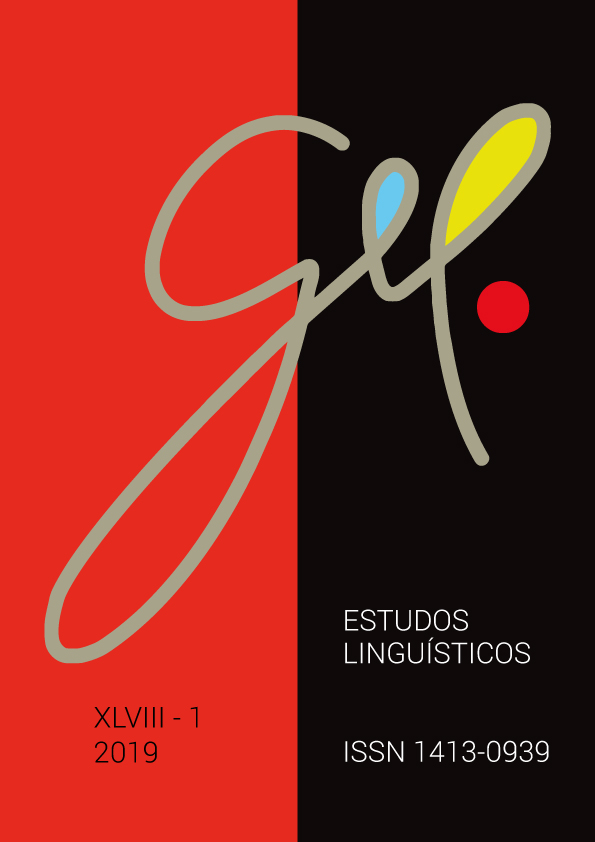Uma análise acústica da palavra “este” do espanhol em função metadiscursiva
DOI:
https://doi.org/10.21165/el.v48i1.2369Parole chiave:
prosódia, marcador discursivo, língua espanholaAbstract
No presente trabalho, analisamos comparativamente as características acústicas da palavra morfológica este da língua espanhola em uso metadiscursivo (filler/marcador discursivo) com as que se observam para a mesma em uso referencial (adjetivo/ pronome). O objetivo da análise é verificar se, em uso metadiscursivo, a palavra apresenta regularidades quanto aos parâmetros F0 (frequência fundamental) e duração, do mesmo modo como em uso referencial, e se possíveis irregularidades são previsíveis. Nossa hipótese é que, em uso metadiscursivo, encontram-se diferentes padrões de F0 e duração para a palavra, sendo que cada um deles corresponde a um distinto matiz semânticopragmático. A investigação se insere dentro do domínio dos estudos prosódicos, utiliza procedimentos da Fonética Experimental, e também recorre a subsídios da Psicolinguística para a interpretação qualitativa dos dados.Downloads
Riferimenti bibliografici
CABEDO-NEBOT, A. Segmentación prosódica de la conversación coloquial: sobre el grupo entonativo como mecanismo demarcativo de unidades mínimas. 2009. Tesis (Doctoral) – Universitat de València, València, 2009.
CLARK, H. H.; FOX TREE, J. E. “Using Uh and Um in Spontaneous Speaking”. Cognition, p. 73-111, 2002. Disponível em: https://www.sciencedirect.com/science/article/pii/S0010027702000173?via%3Dihub. Acesso em: 22 mar. 2018.
FERRARA, K, Form and function of the discourse marker “anyway”: Implications for discourse analysis. Linguistics, v. 35, p. 343-378, 1997.
FERREIRA NETTO, W. (org.). ExProsodia: resultados preliminares. São Paulo: Paulistana, 2016.
FOX, B. A. Introduction. In: AMIRIDZE, N.; DAVIS, B. H.; MACLAGAN, M. (ed.). Fillers Pauses and placeholders. Amsterdam/Philadelphia: John Benjamins [Typological Studies in Language 93], 2010. p. 1-11.
GALUÉ, D. Marcadores conversacionales: un análisis pragmático. Boletín de Lingüística, v. 18, p. 27-46, 2002. Disponível em: https://biblat.unam.mx/es/revista/boletin-de-linguistica/articulo/marcadores-conversacionales-un-analisis-pragmatico. Acesso em: 19 jan. 2018.
MARTÍN-BUTRAGUEÑO, P. “Hacia una descripción prosódica de los marcadores discursivos – Datos del español de Méjico”. In: MARTÍN-BUTRAGUEÑO, P. M.; HERRERA, E. La tonía: dimensiones fonéticas y fonológicas (Estudios linguisticos y literarios / Linguistic and literary studies) (Spanish Edition) January 1, 2003. Disponível em: https://lef.colmex.mx/Sociolinguistica/Entonacion%20del%20espanol%20mexicano/Marcadores%20discursivos.pdf. Acesso em: 06 jun. 2017.
MARTÍN-ZORRAQUINO, M. A.; PORTOLÉS, L. J. Los marcadores del discurso. In: DEMONTE, V.; BOSQUE, I. (coord.). Gramática descriptiva de la lengua española. v. 3 (Entre la oración y el discurso. Morfología). Madrid: Espasa-Calpe, 1999. p. 4051-4214.
MARTÍNEZ-HERNÁNDEZ, D. Análisis pragmaprosódico del marcador discursivo bueno. VERBA, v. 43, p. 77-106, 2016. Disponível em: http://www.usc.es/revistas/index.php/verba/article/view/1888. Acesso em: 23 nov. 2017.
MARTINEZ, H.; URDANETA, L.; DOMÍNGUEZ, C. L. Estudio fonético-sintáctico de algunos marcadores discursivos: propuesta de formalización para desambiguarlos automática o informaticamente. Lengua y Habla, v. 8, p. 57-79, 2003-2004. Disponível em: https://dialnet.unirioja.es/servlet/articulo?codigo=4003973. Acesso em: 05 mai. 2018.
WATANABE, M. The constituent complexity and types of fillers in Japanese. Proceedings of the 15 th International Congress of Phonetic Sciences, Barcelona, p. 2473-2476, 2003. Disponível: https://www.internationalphoneticassociation.org/icphs-proceedings/ICPhS2003/papers/p15_2473.pdf. Acesso em: 09 nov. 2017.
WATANABE, M.; ROSE, R. Pausology and hesitation phenomena in second language acquisition. The Routledge Encyclopedia of Second language Acquisition, p. 480-483, 2012.
WENNERSTROM, A. The music of everyday speech – Prosody and Discourse Analisis. New York: Oxford Press, 2001.



